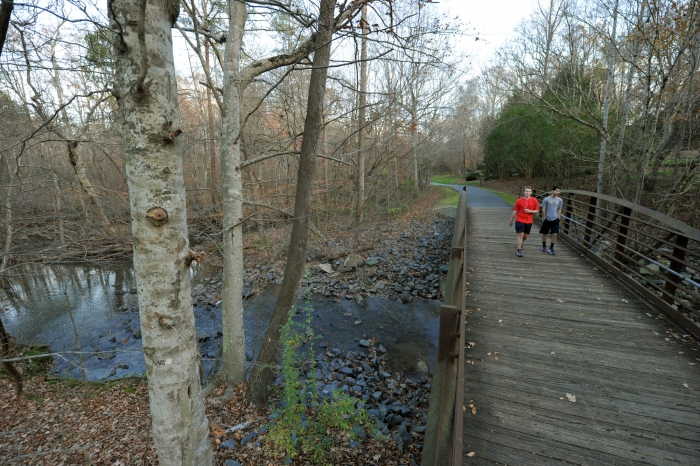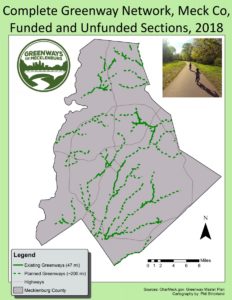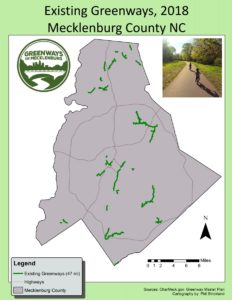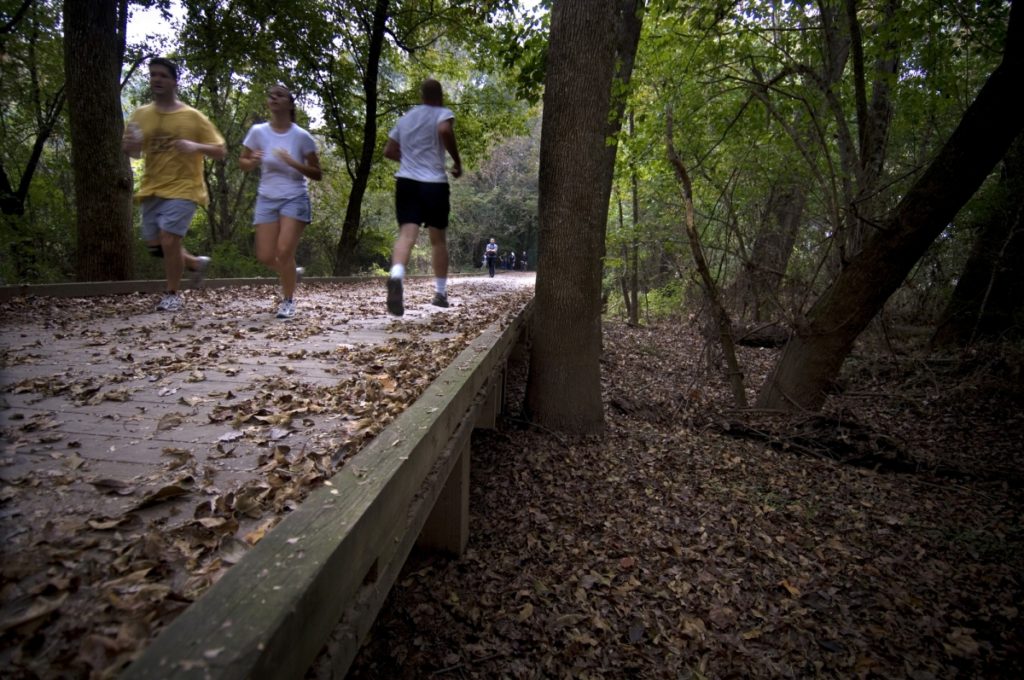
Along the Clark’s Creek Greenway in the Mallard Creek watershed of northeast Mecklenburg County. Photo: Nancy Pierce
Rick Winiker | Feb 22, 2018
Almost 40 years ago, Charlotte-Mecklenburg recognized greenways “as logical natural elements useful in creating a sense of physical form and order within the city .… ” The 1980 greenway master plan called for a 73-mile network of trails along 14 creek corridors, a “green necklace” around the county. In 1999, the Mecklenburg county commissioners approved a 10-year master plan goal of 184.9 miles. But by 2008, the county had constructed only 30 miles of trails. The county’s 2008 Greenway Master Plan offered a 10-year goal “[t]o construct 61.9 miles of new greenway trail by 2018, bringing the total miles of constructed greenway trail to 129.”
It’s 2018, and Mecklenburg County has only 47 miles of developed greenways.
A vision exists (there isn’t enough commitment to even call it a “plan”) of a 200-mile greenway network in Mecklenburg County. However, there is neither commitment nor funding to complete a connected greenway network in this county in our lifetime (even for the more youthful readers of this article).
 After a recent push to finally fund neglected parks projects from a 2008 bond measure that won 60 percent approval from county voters (those bonds were never issued because of the 2008 financial crisis), Mecklenburg county commissioners finally funded those remaining projects last year.
After a recent push to finally fund neglected parks projects from a 2008 bond measure that won 60 percent approval from county voters (those bonds were never issued because of the 2008 financial crisis), Mecklenburg county commissioners finally funded those remaining projects last year.
Yet the county manager nevertheless structured the funding for those parks projects so that they will be delayed for years. For instance, a section of a future Briar Creek Greenway near the Plaza-Midwood neighborhood was on the list of greenway segments to be finished by 2018. But the funding has been structured so that even planning for it cannot begin until 2024. So that short segment, intended to have been finished this year, won’t be finished for probably another 15 years.
At the current pace of construction, a connected greenway network in Mecklenburg County will not be completed for more than 40 or 50 years.
Part of the vision for the 200-mile greenway network includes the city/county partnership that is paying for one trail, the Cross-Charlotte (#XCLT) trail. That partnership came about when the City of Charlotte in 2013 offered to help the county finish building a proposed greenway from the South Carolina line, through the city, to the Cabarrus County line. The city has earmarked $30 million from two bond issues, with $5 million more expected from a 2018 bond referendum, to make completing that trail a reality.
 That city-county funding partnership is notable because Charlotte does not have a park and recreation department. In 1992 the city and county park departments merged. The county-funded Mecklenburg County Park and Recreation Department is responsible for building and maintaining greenways in Charlotte and Mecklenburg County.
That city-county funding partnership is notable because Charlotte does not have a park and recreation department. In 1992 the city and county park departments merged. The county-funded Mecklenburg County Park and Recreation Department is responsible for building and maintaining greenways in Charlotte and Mecklenburg County.
A 2016 survey of Mecklenburg County residents by the Parks and Recreation Department found that 76 percent of all households listed paved walking and biking trails as the No. 1 request for park and recreation facilities – higher than sports fields, recreation centers or playgrounds. This preference is not new. A similar, 2008 county survey found 74 percent of all households surveyed voted for walking and biking trails as their top request.
While greenways are not cheap – current costs are an estimated at $1 million to $2 million per mile – they are among the cheapest infrastructure investments with the greatest return. For example, the Atlanta BeltLine – a 22-mile greenway trail being built around metro Atlanta – generated an 8 to 1 return on investment in the first 10 years of the project. After public-private spending of $447 million – from sources such as the city of Atlanta, philanthropic contributions, government grants, etc. – the trail has seen private development worth $3.7 billion. Return on investment on the Little Sugar Creek section of the Cross-Charlotte Trail greenway has been measured at 10 to 1. Besides commercial investments along greenways, a connected network would offer equitable transportation alternatives our city and county desperately need.
The cost to build greenways only goes up with time. Land will become more scarce and more expensive the longer we wait. Current estimates show the city of Charlotte gaining 44 residents a day. Growth projections for 2030 estimate the equivalent of the cities of Minneapolis or Cleveland moving here. These new neighbors will not bring infrastructure – especially streets and parks.
A new nonprofit group, Greenways for Mecklenburg, is urging the county to adopt and fund a plan to complete a 200-mile network by 2035. (Disclosure: I’m on the board of that group.) Instead of the current pace of 3 to 4 miles per year (and the 10-year average has been only 1.7 miles per year), we should complete 9 to 10 miles of greenways per year. Accomplishing that goal would require more people working in the park and recreation, land acquisition, and county asset and facilities management departments. A greenway network is possible if we also have 20 to 25 miles of greenway always in design or construction.
The county has not committed the resources we need to identify and preserve adequate greenspace for future parks and greenways – especially inside the I-485 beltline. Meanwhile, we are enjoying record county property tax revenues. If we don’t make a commitment to a complete greenway network now, when will we?

Along the McMullen Creek Greenway in south Charlotte. Photo: Nancy Pierce
Rick Winiker is a local attorney and a board member of Greenways for Mecklenburg and the Chantilly Neighborhood Association. He serves as a Mecklenburg County Park and Recreation commissioner, but the views expressed here are not made on behalf of the Park and Recreation Commission. In addition, opinions expressed here are not necessarily those of the UNC Charlotte Urban Institute or the University of North Carolina at Charlotte.
